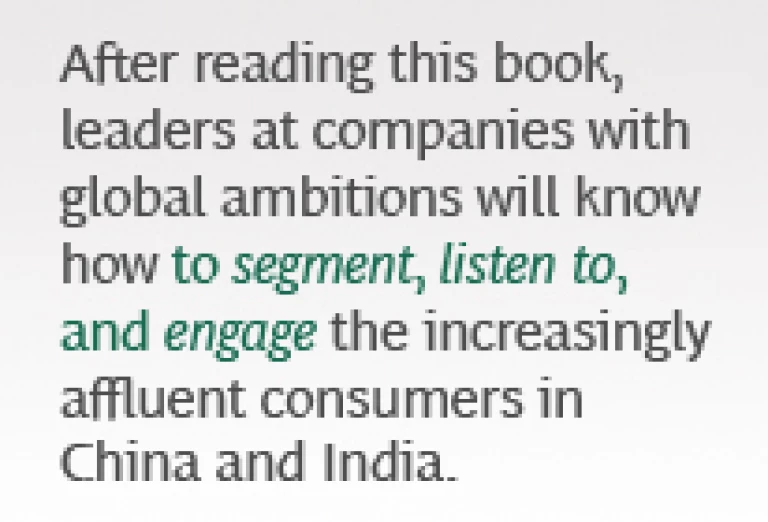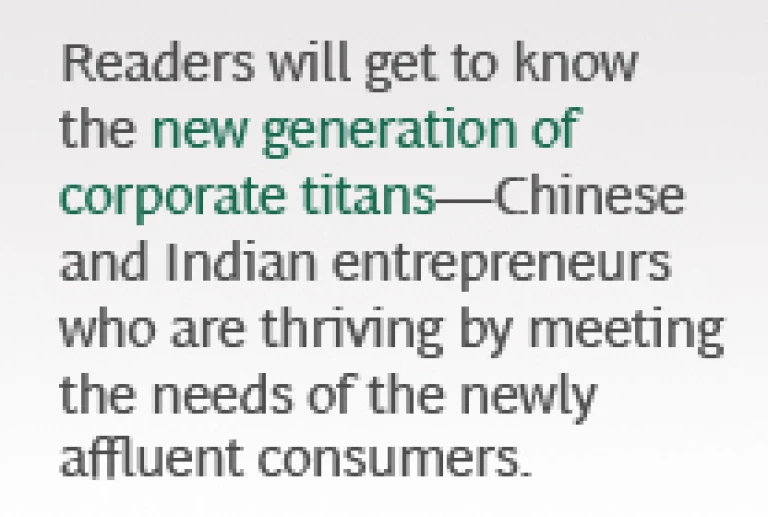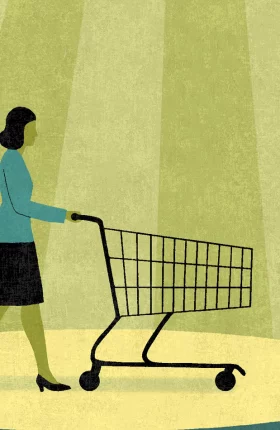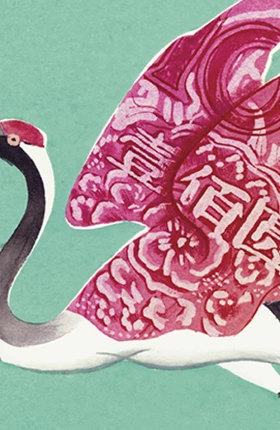Preface
The following excerpts come from The $10 Trillion Prize published by Harvard Business Review Press.
The $10 Trillion Prize
- An Interactive Guide to the $10 Trillion Prize
- Captivating the Newly Affluent in China and India
- The Book in Brief: An Executive Summary
- Michael J. Silverstein on The $10 Trillion Prize
New Consumers, New Opportunities
Consumers in India and China are the new kings and queens of the global economy. They have fast-changing tastes and appetites, and they are transforming the world with their consumption. Consider the following facts, which provide a snapshot of what the opportunity is for the rest of this decade:
- There will be nearly one billion middle-class consumers—some 320 million households—in China and India by 2020. They are demanding “more, better, now” for themselves and their children.
- The number of billionaires is rising: in 2001, China had 1 billionaire and India had 4; today, there are 115 billionaires in China and 55 in India.
- The two markets will give rise to some of the world’s most powerful companies. China already has three of the world’s top ten companies, ranked by market value: PetroChina, China’s ICBC bank, and China Mobile.
- Some eighty-three million Chinese and fifty-four million Indians will become college graduates over the next ten years. Over the same period, the United States will see just thirty million new college graduates.
- The rapid growth in both China and India has led to enormous growth in the consumption of the building blocks of households—from copper to corn to chicken to coal—plus almost every other ingredient important to better lives, particularly a diet higher in protein but also vertical dwellings with modern conveniences and vehicles of transportation of all kinds.
We estimate that the consumer markets of China and India will triple over the current decade and amount to $10 trillion annually by the year 2020. It is a once-in-a-lifetime prize. But how can it be won? That is the purpose of this book. The $10 Trillion Prize presents a manual for growth: the inside track to achieving success in China and India—and, as a consequence, the rest of the world—by captivating, and therefore winning, the hearts and minds of the new consumers.
We also build on the insights drawn from our prior work on consumer needs, including research that we published in the books Trading Up: The New American Luxury (2003); Treasure Hunt: Inside the Mind of the New Consumer (2006); and Women Want More: How to Capture Your Share of the World’s Largest, Fastest-Growing Market (2010).
In Trading Up, for example, we identified the trend among middle-class Americans to buy more expensive goods in a handful of product categories and to become expert in the art of consumption—looking for technical, functional, and emotional benefits in products and services. Over the past two years, we have traveled throughout China and India and seen many parallels. Chinese and Indian consumers are also hungry for product information—they want to understand the back stories of products and their creators. They are allocating their budgets to achieve a visible level of affluence in many categories of goods and cutting corners in others to achieve necessary savings. The Chinese and Indian consumers are ambitious and dream big. They understand technical and functional differences and love to “ladder up” emotionally. They love to tell their friends about their shopping adventures and to celebrate their purchases.
The $10 Trillion Prize is based on both qualitative and quantitative consumer research. We studied Chinese and Indian consumers in their homes, meeting their families and discussing their current and anticipated lifestyles. We probed them about their diets, their purchases, their histories, and their hopes and dreams. Readers will get to know the new generation of consumers, including the brilliant student we call “Mr. Number 19” because of his ranking on the highly competitive entrance exam to the Indian Institutes of Technology; the determined thirty-three-year-old woman from Shanghai who already makes more than fifty times as much as her parents did and still wants more; and the fifty-nine-year-old rural Chinese woman with three years of formal education who has built her home brick-by-brick and constructed a garage for the car she would like to buy one day.
Readers will also get to know the new generation of corporate titans—Chinese and Indian entrepreneurs who are thriving by meeting the needs of the newly affluent consumers—including Frank Ning, who runs Cofco, one of the world’s biggest food processing companies; Adi Godrej, chairman of the Godrej Group, one of India’s biggest consumer goods conglomerates; and Anand Mahindra, vice chairman and managing director of Mahindra & Mahindra, India’s major manufacturer of tractors and low-cost—and now global—sport utility vehicles.
The Promise of the Book
The $10 Trillion Prize is written for leaders who need a better understanding of the consumers in China and India. It carries ten key messages:
1.For the first time, we calculate the size of the prize: the $10 trillion that Chinese and Indian consumers will be spending on goods and services in 2020. Over their lifetimes, Chinese children born today will consume nearly thirty-eight times as much as their grandparents did, while Indian children will consume nearly thirteen times as much as their grandparents did.
2.We describe the driving spirit of the consumers: their ambition, their energy, their confidence, their optimism. As a young Chinese woman told us, “I want two houses—a house in the city and a house in the country. I want two children. And I want to send them to school in America. I want beautiful clothes, a handsome, educated husband, and time to enjoy it all.”
3.We stress the need to segment and target these consumers—not only by income but also by region, city, rural community, and gender. The great engine of change is the rising middle class: by 2020, an astonishing 320 million increasingly affluent households whose nearly one billion members will be following their dreams and, in so many ways, emulating Western consumers. In addition, there are the millions of poor, now moving beyond survival, as well as the superrich (more than 1 million households), now joining the global elite. But it is not enough to divide consumers by class. To survive in the big city, you need more income, more hustle, and a tolerance for long commutes. As we will see, middle-class consumers in a megacity such as Beijing or Mumbai can exhibit altogether different patterns of behavior than those in smaller cities. You need to understand these consumers, personify them, and cater to their individual needs.
4.We recommend the adoption of a paisa vasool—literally, “money’s worth”—strategy. Chinese and Indian consumers will be hungry for material goods over the next decade. They will want more than they can afford. Their income growth will be substantial, even if they will still end the decade earning only 10 to 25 percent of Western incomes. They will want goods with full features, luxury elements, and reliability. To serve these consumers, you will need not only raw material and packaging innovations but also a comprehensive, low-cost business model. And these will be transferrable to other markets because consumers around the world will want products that do not compromise on features, ingredients, design, or value.
5.We urge the importance of “local, local” customization. These consumers need to have products and services that are tailored to them—and them alone. If they are rich or poor, if they are urban or rural, if they live in a big city or a little city, if they live in the north or the south, if they are educated or illiterate—all of these factors matter and require refinements to the product and the way it is designed, packaged, and sold. China and India are markets with heterogeneous populations demanding locally customized products.
6.We identify the accelerator mind-set. Speak to entrepreneurs in China or India, and they talk of their ten-by-ten strategy of growing tenfold in ten years. If this sounds extraordinary—even unattainable—in the West, it sounds perfectly rational in the East. Today, in China and India, there is a determined, can-do attitude, and the word impossible is not one commonly heard on the lips of business leaders. Strategy is as they see it: a big-picture vision, colossal dreams, and no limits on opportunity. They do not feel beholden to anyone or bound by text-book business rules and the constraints of commonly held business logic. They start with a clean slate, focus on a specific opportunity, scale up or refocus as needed, learn by doing, and drive relentlessly forward.
7.We introduce the notion of a boomerang effect. The impact of more than two billion consumers wanting more—more foodstuffs, water, housing, transport, luxury goods, education, and health care—will be inflation in supply-constrained commodities, price volatility, scarcity of some resources, and hypercompetition to meet consumers’ needs. The boomerang effect will spread far beyond China and India.
8.We warn of the hit-the-wall scenario. What if China and India do not continue on the path of marvelous straight-line growth? Political instability, natural disasters, bursting asset bubbles, rotten and corrupt institutions, the failure of government entities to invest in the future—each of these could cause projections of growth to veer dangerously off course, with cataclysmic consequences for China, India, and the companies that are pinning their hopes on the new and dynamic generation of consumers. This is why we say that it is important to factor these risks and hazards into any scenario planning process. It is important to be alive to the possibility that the story of “Asia Rising” could change into the story of “Asia Uprising.” The successful future development of China and India depends upon the ability of their leaders and citizens to solve many difficult challenges.
9.We portray the left-behinds—millions of people who, for all the success of the Chinese and Indian economies, remain disconnected and disgruntled with their lot. For now, they offer limited commercial opportunities, but they could offer the prospect of a second wave of growth as the Chinese and Indians pursue policies to foster social harmony.
10.We maintain that there is no inevitability about the decline of the West. We are profoundly optimistic—yet, we think, measured and realistic—about the opportunities in China and India and the positive impact on the global economy, on companies, and on individuals. It was not so long ago that political commentators and historians were talking about the triumph of the West. Now they are talking about decline and the fall of the American empire. But we do not consider this likely. On average, American and European consumers are vastly richer than Chinese and Indian consumers—and this is not going to change anytime soon. If Americans and Europeans adopt the accelerator mind-set, opportunity and growth will rebound. We believe that the consumer revolution is awinner for all, a force for good that can benefit everyone. The new interactions between East and West are energizing, enlightening, and empowering—and ensure that companies and their leaders look far beyond the horizon to a world of infinite possibilities.
We hope you use this book to see the market opportunity in China and India through the eyes of consumers moving from D income to C income, from C income to B income, and from B income to A income. We offer a checklist of requirements for success along with our assessment of risks and how to mitigate them.After reading this book, leaders at companies with global ambitions will know how to segment, listen to, and engage the increasingly affluent consumers in China and India. It is easy to be swayed by the sheer number of consumers in the two countries and to think that success is just a matter of selling to a small fraction of them. But averages can be deceptive, and off-the-shelf statistics and generalized data can lead companies into making bad decisions and expensive mistakes.
We want readers to take the following steps in engaging the new markets in China and India:
- Meet consumers “up close and personal”: understand how they make decisions about goods and how their hopes for the future translate into astounding market growth in food, health care, education, and transport.
- Understand the size, shape, and timing of the opportunity. Segment the market according to income and geography—especially the urban and rural divide. See how the application of special “consumption curves” can predict the future.
- Build the paisa vasool approach—the perfect mix of affordability, design, and features—into your global tool kit. Engineer every product and service with this approach. Make value for money the standard in Chinese, Indian, and Western markets.
- Hear how market leaders are shaping their future with a ten-by-ten strategy: ten times as big in ten years.
- Systematically understand risk and risk reduction in the world’s most challenging markets.
- Use the book to create what we call the triple crown: a win in China, a win in India, and a win at home.
- See how Chinese and Indian consumers will shape a new future for the world—and how they will do so with drama, emotion, conflict, and hard choices.
- Understand the differences and similarities between China and India: one child versus five children; autocracy versus democracy; speed and authority versus choice; massive investment with few market safeguards versus returns guarded by capital markets; state capitalists versus private entrepreneurs.
- Ask questions that will unlock spectacular growth and organizational resolve in China and India.
The Research: Client Work, Interviews, and Data
The $10 Trillion Prize is based on extensive on-the-ground experience, one-on-one interviews with hundreds of consumers, and access to business leaders and entrepreneurs in China and India.
Our company, The Boston Consulting Group (BCG), has a long history of advising clients and governments in these countries. In China, we began work in the 1980s, opened an office in Hong Kong in 1991, and were the first multinational consulting company to be authorized to conduct business in mainland China, establishing an office in Shanghai in 1993. Our office in Beijing opened in 2001. In India, we opened our Mumbai office in 1996, after nearly a decade of work in the country. The New Delhi office opened its doors in 2000. This year, we opened our third Indian office, in Chennai.
As an author team, we are veterans of these markets. Together, we have more than fifty years of on-the-ground experience in China and India, stretching back to the 1980s. We have advised major Chinese and Indian companies as well as multinationals seeking to enter these countries and build their businesses there. Our clients—some of the world’s largest consumer companies—have turned to us for advice on innovation, market access, distribution, and consumer understanding. Throughout The $10 Trillion Prize, we draw on a valuable resource: the proprietary consumer-tracking studies produced by BCG’s Center for Consumer and Customer Insight. Across Asia, the center has conducted some five hundred consumer insight projects over the past ten years. The flagship is an annual global consumer sentiment survey of twenty-four thousand people in twenty-one countries.
The Structure of the Book
The $10 Trillion Prize is arranged in three parts, which are preceded by an introduction (chapter 1).
In chapter 1, we tell the story of the dramatic growth in consumption and quantify the size of the commercial opportunity: the $10 trillion in annual spending that the consumer markets of China and India will generate by the year 2020. We explain how consumers’ rising income—which takes them, in many cases, from subsistence to middle class—seems like the wheel of fortune: they truly feel as though they have won the jackpot.
The $10 Trillion Prize is written for leaders who need a better understanding of the consumers in China and India. It carries ten key messages:
- For the first time, we calculate the size of the prize: the $10 trillion that Chinese and Indian consumers will be spending on goods and services in 2020. Over their lifetimes, Chinese children born today will consume nearly thirty-eight times as much as their grandparents did, while Indian children will consume nearly thirteen times as much as their grandparents did.
- We describe the driving spirit of the consumers: their ambition, their energy, their confidence, their optimism. As a young Chinese woman told us, “I want two houses—a house in the city and a house in the country. I want two children. And I want to send them to school in America. I want beautiful clothes, a handsome, educated husband, and time to enjoy it all.”
- We stress the need to segment and target these consumers—not only by income but also by region, city, rural community, and gender. The great engine of change is the rising middle class: by 2020, an astonishing 320 million increasingly affluent households whose nearly one billion members will be following their dreams and, in so many ways, emulating Western consumers. In addition, there are the millions of poor, now moving beyond survival, as well as the superrich (more than 1 million households), now joining the global elite. But it is not enough to divide consumers by class. To survive in the big city, you need more income, more hustle, and a tolerance for long commutes. As we will see, middle-class consumers in a megacity such as Beijing or Mumbai can exhibit altogether different patterns of behavior than those in smaller cities. You need to understand these consumers, personify them, and cater to their individual needs.
- We recommend the adoption of a paisa vasool—literally, “money’s worth”—strategy. Chinese and Indian consumers will be hungry for material goods over the next decade. They will want more than they can afford. Their income growth will be substantial, even if they will still end the decade earning only 10 to 25 percent of Western incomes. They will want goods with full features, luxury elements, and reliability. To serve these consumers, you will need not only raw material and packaging innovations but also a comprehensive, low-cost business model. And these will be transferrable to other markets because consumers around the world will want products that do not compromise on features, ingredients, design, or value.
- We urge the importance of “local, local” customization. These consumers need to have products and services that are tailored to them—and them alone. If they are rich or poor, if they are urban or rural, if they live in a big city or a little city, if they live in the north or the south, if they are educated or illiterate—all of these factors matter and require refinements to the product and the way it is designed, packaged, and sold. China and India are markets with heterogeneous populations demanding locally customized products.
- We identify the accelerator mind-set. Speak to entrepreneurs in China or India, and they talk of their ten-by-ten strategy of growing tenfold in ten years. If this sounds extraordinary—even unattainable—in the West, it sounds perfectly rational in the East. Today, in China and India, there is a determined, can-do attitude, and the word impossible is not one commonly heard on the lips of business leaders. Strategy is as they see it: a big-picture vision, colossal dreams, and no limits on opportunity. They do not feel beholden to anyone or bound by text-book business rules and the constraints of commonly held business logic. They start with a clean slate, focus on a specific opportunity, scale up or refocus as needed, learn by doing, and drive relentlessly forward.
- We introduce the notion of a boomerang effect. The impact of more than two billion consumers wanting more—more foodstuffs, water, housing, transport, luxury goods, education, and health care—will be inflation in supply-constrained commodities, price volatility, scarcity of some resources, and hypercompetition to meet consumers’ needs. The boomerang effect will spread far beyond China and India.
- We warn of the hit-the-wall scenario. What if China and India do not continue on the path of marvelous straight-line growth? Political instability, natural disasters, bursting asset bubbles, rotten and corrupt institutions, the failure of government entities to invest in the future—each of these could cause projections of growth to veer dangerously off course, with cataclysmic consequences for China, India, and the companies that are pinning their hopes on the new and dynamic generation of consumers. This is why we say that it is important to factor these risks and hazards into any scenario planning process. It is important to be alive to the possibility that the story of “Asia Rising” could change into the story of “Asia Uprising.” The successful future development of China and India depends upon the ability of their leaders and citizens to solve many difficult challenges.
- We portray the left-behinds—millions of people who, for all the success of the Chinese and Indian economies, remain disconnected and disgruntled with their lot. For now, they offer limited commercial opportunities, but they could offer the prospect of a second wave of growth as the Chinese and Indians pursue policies to foster social harmony.
- 10.We maintain that there is no inevitability about the decline of the West. We are profoundly optimistic—yet, we think, measured and realistic—about the opportunities in China and India and the positive impact on the global economy, on companies, and on individuals. It was not so long ago that political commentators and historians were talking about the triumph of the West. Now they are talking about decline and the fall of the American empire. But we do not consider this likely. On average, American and European consumers are vastly richer than Chinese and Indian consumers—and this is not going to change anytime soon. If Americans and Europeans adopt the accelerator mind-set, opportunity and growth will rebound. We believe that the consumer revolution is awinner for all, a force for good that can benefit everyone. The new interactions between East and West are energizing, enlightening, and empowering—and ensure that companies and their leaders look far beyond the horizon to a world of infinite possibilities.
We hope you use this book to see the market opportunity in China and India through the eyes of consumers moving from D income to C income, from C income to B income, and from B income to A income. We offer a checklist of requirements for success along with our assessment of risks and how to mitigate them.
The Contest for the $10 Trillion Prize Has Begun
China and India are very different in many ways. So why put them together in a book? The answer is simple: the increasing size of their populations, the growing power of their economies, and—most important of all—the emerging mass of ambitious, educated, middle-class consumers who want more now. The two countries combine to represent the number one and number two consumer opportunities of today. Both countries have enormous upside. The increase in annual consumption by 2020 will be $4.2 trillion in China and $2.6 trillion in India. Anyone with global aspirations will need to compete successfully in both China and India.
There are some who fear China’s and India’s growth, viewing it as a harbinger of doom for companies in developed economies. But we do not see it this way. We think it heralds a bright new future with abundant opportunities for those willing to seize the moment.
In the classic film On the Waterfront, Marlon Brando plays the role of Terry Malloy, a former heavyweight boxer who once had a shot at winning a big title but blew his chance. Far from being a champion, he works as a day laborer on the docks of New Jersey. “I could have had class,” he says regretfully. “I could have been a contender.” Today’s leaders need not have any such regrets—as long as they act fast.
There is no time to lose. The contest has begun.
Pre-order the book at
Amazon
or
Barnes & Noble
.












